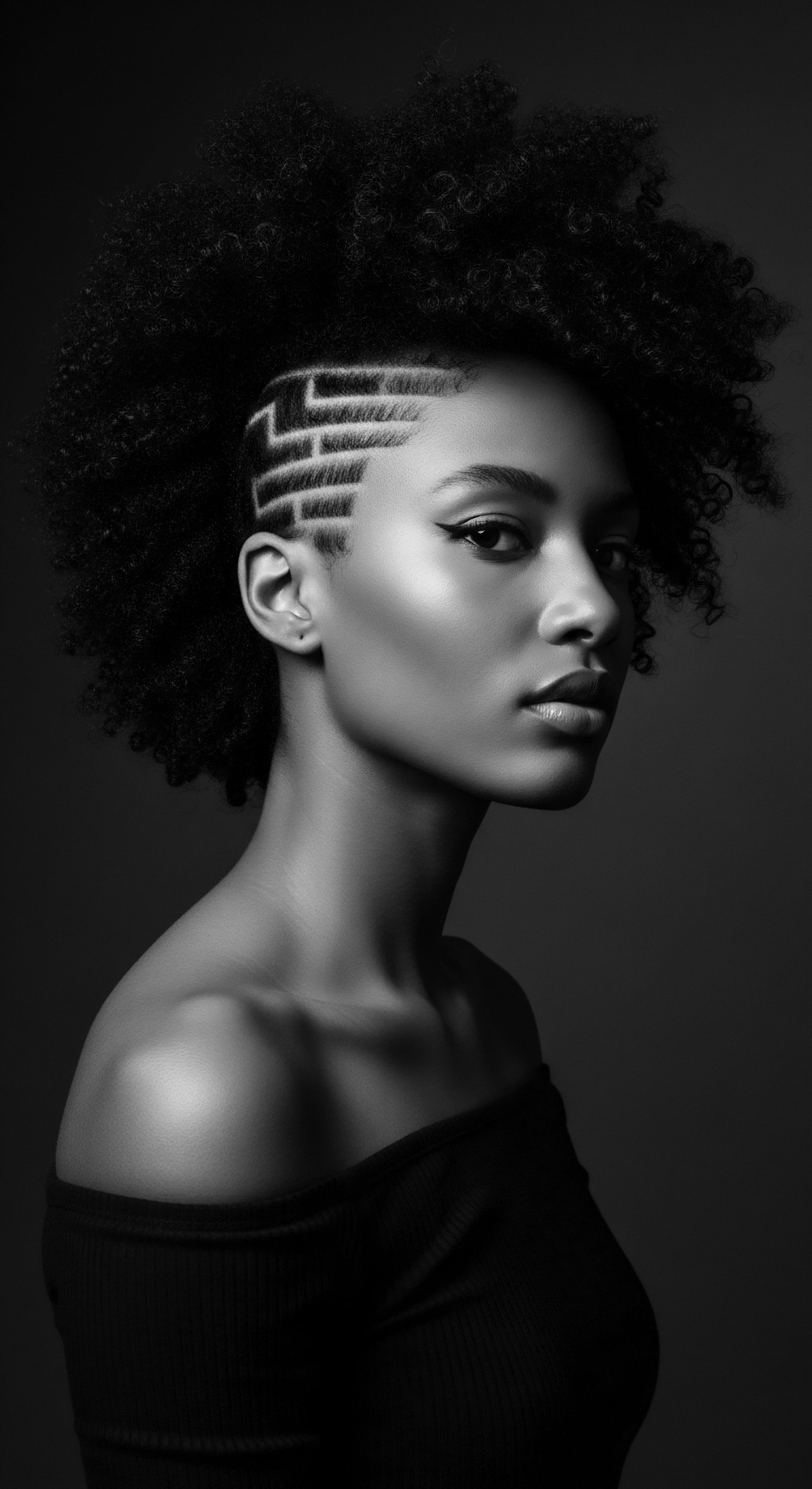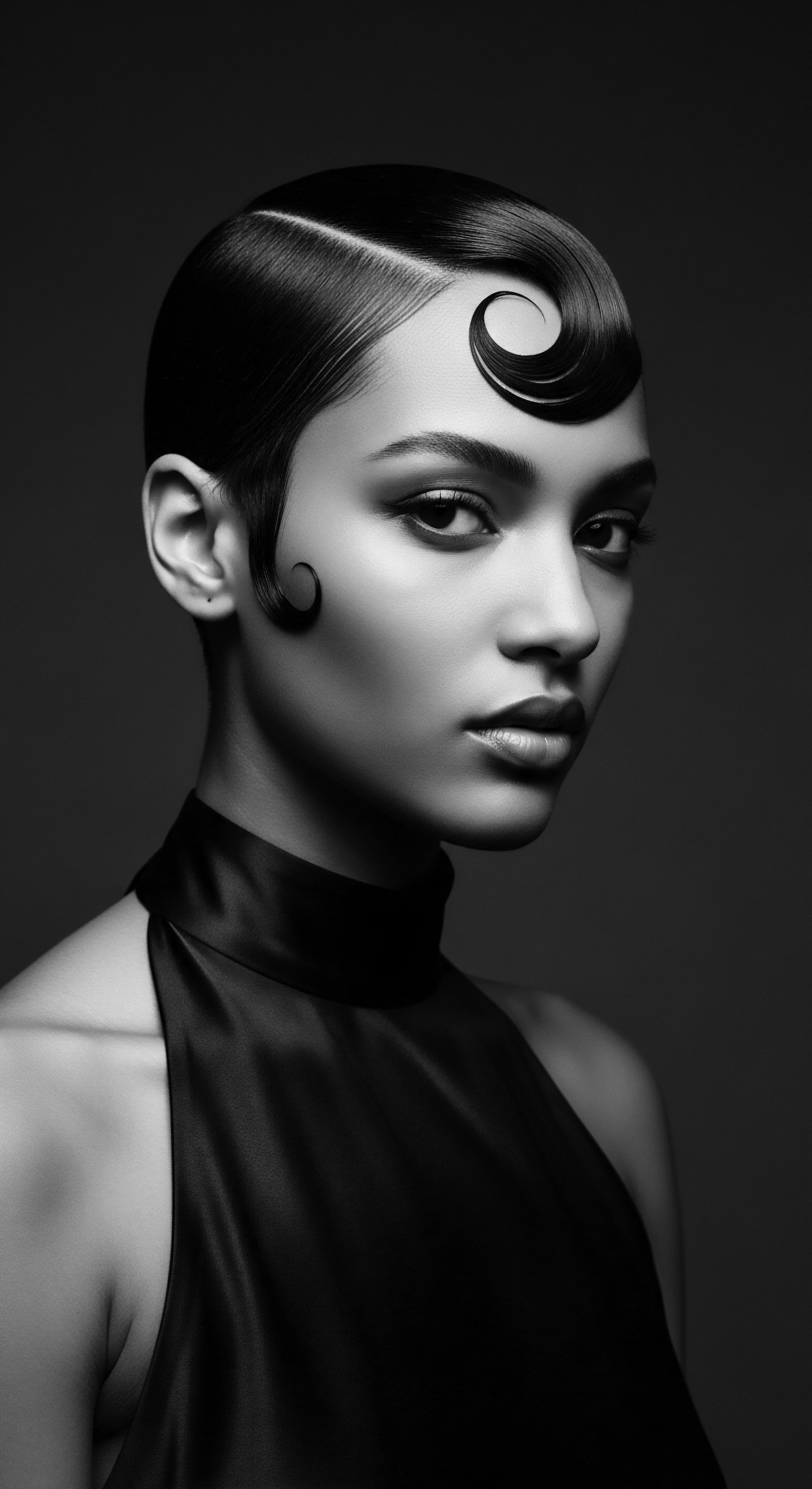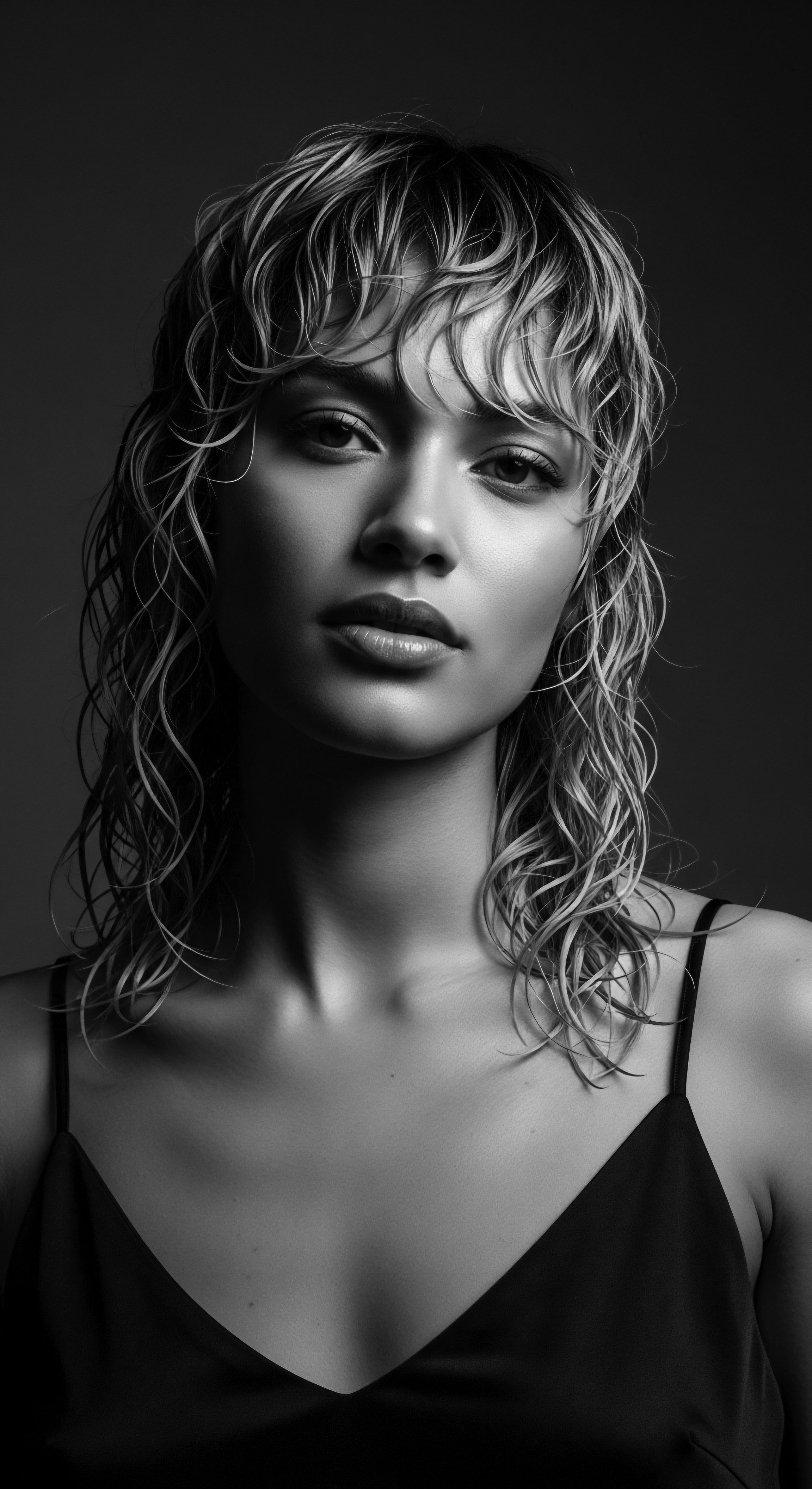
Roots
To truly comprehend the intricate dance of caring for textured hair, one must first feel the quiet whisper of generations, the rhythmic hum of ancient wisdom echoing through each coil and curl. Your strands, more than mere protein structures, are living archives, repositories of ancestral knowledge, braided histories, and the resilience of a people. This journey into what traditional practices inform textured hair care begins at the very source, at the elemental biology that shapes its remarkable architecture, inextricably linked to the cultural ingenuity born of necessity and celebration. The heritage of textured hair care is not a static relic; it is a dynamic, living lineage.

The Intrinsic Architecture of Textured Hair
The unique helical structure of textured hair, often described as elliptical or kidney-bean shaped in cross-section, distinguishes it from its straighter counterparts. This distinct morphology, along with the varying distribution of disulfide bonds and the curvature of the follicle itself, contributes to its natural inclination to coil, crimp, and wave. From a scientific perspective, this structural complexity can also explain its propensity for dryness and fragility if not managed with understanding. Historically, however, this very structure was revered, shaping grooming practices across vast swathes of Africa and its diaspora.
Early societies intuitively understood that these coils required particular attention, a wisdom passed down not through scientific papers, but through the patient hands of mothers, aunties, and village elders. The communal nature of hair care, often occurring under the shade of a baobab tree or within the confines of family compounds, fostered an oral tradition of practical knowledge.
Consider the deeply ingrained understanding of moisture retention. Arid climates and the physical demands of daily life meant that hair needed protection from the elements. Traditional practices, long before the advent of modern chemistry, centered on creating barriers and infusing hydration. This innate understanding of the hair’s need for moisture protection, so central to traditional practices, finds its scientific validation today in studies demonstrating the increased evaporative water loss from highly coily hair compared to straighter textures (Myers et al.
2013). This validates a truth held for centuries ❉ hydration is paramount.
Textured hair, a living archive of ancestral knowledge, demands care born from generations of intuitive wisdom.

Ancestral Categorization of Hair
Before modern classification systems like Andre Walker’s, communities held their own ways of describing and understanding hair textures. These were often less about rigid numerical types and more about descriptive qualities ❉ how the hair held style, its relative softness or coarseness, and its response to moisture. In many West African cultures, for instance, hair was described in terms of its ability to be manipulated into specific cultural styles, reflecting its “spirit” or responsiveness. A particular texture might be ideal for intricate cornrows, while another was preferred for soft, loose twists.
The names given to hairstyles often embodied these textural qualities, speaking to the hair’s inherent characteristics and its suitability for various forms of artistic expression and protection. This organic lexicon, rooted in practical application and aesthetic appreciation, predates any laboratory analysis.
The hair growth cycle, though a universal biological process, was observed with keen ancestral eyes. While not articulated in terms of anagen, catagen, and telogen phases, traditional care rituals often aligned with these natural rhythms. For example, hair was sometimes allowed to rest for periods in protective styles, mirroring the hair’s need for minimal manipulation during its shedding phase.
Special care might be given during periods of illness or postpartum, when changes in the body could visibly impact hair density and health. This attunement to bodily rhythms and their reflection in hair was a cornerstone of ancient wellness philosophies.

The Earliest Hair Care Lexicon
The language of textured hair care stretches back through time, with words and concepts often interwoven with the very fabric of daily life. These terms, whispered from one generation to the next, described tools, preparations, and techniques long before they were given scientific labels.
- Kongo Combs ❉ Intricately carved combs from the Kongo Kingdom, used for detangling and styling, embodying both utility and artistic expression.
- Shea Butter ❉ Known in many West African languages, this fat from the shea nut tree was (and remains) a universal moisturizer and sealant for hair and skin.
- Palm Oil ❉ A traditional emollient and conditioner in many African cultures, recognized for its nourishing properties.
- Bantu Knots ❉ A style of knotting hair close to the scalp, a testament to the ingenuity of protective styling, with roots across various African ethnic groups.

Ritual
The meticulous styling of textured hair transcends mere aesthetics; it is a ritual, a profound expression of identity, status, and spiritual connection. Through millennia, practices of braiding, twisting, coiling, and adornment have transformed hair care into a living art form, each stroke and strand speaking volumes about an individual’s lineage, community, and personal journey. What traditional practices inform textured hair care here are not just methods, they are ceremonies of continuity, connecting past to present in a tangible, beautiful way.

The Ancestral Roots of Protective Styling
Protective styling, a foundational practice in textured hair care today, possesses roots that dig deep into the ancestral soils of Africa. Before the demands of modern life, these styles served multi-faceted purposes ❉ safeguarding strands from harsh environments, communicating tribal affiliation, marital status, or age, and serving as a canvas for intricate adornment. The artistry of braiding, for example, found in cultures like the Fulani people, extended beyond practicality, becoming a visual language of symbols and stories. The patterns of braids could indicate a person’s village, social standing, or even readiness for marriage.
These were not quick styles; they were often communal affairs, taking hours or even days, solidifying bonds between the women who shared the experience. This collective effort in grooming ensured the knowledge of complex techniques was passed down with precision and care.
The very idea of “low manipulation” styling, so often discussed today, has always been central to traditional protective styles. By tucking away ends, minimizing tangling, and reducing exposure to external stressors, these styles inherently promoted hair health and length retention.

Natural Styling and Defining Hair
Traditional methods for defining and enhancing natural curl patterns involved an intimate understanding of the hair’s response to moisture and specific natural emollients. Techniques such as finger coiling, pioneered informally through generations, allowed for the intentional shaping of curls, creating definition without harsh chemicals. Water, often combined with mucilaginous plant extracts from ingredients like okra or flaxseed, served as the primary sculpting agent.
These plant-based gels provided hold and hydration, allowing natural textures to be celebrated in their full glory. The emphasis was on enhancing the hair’s innate beauty, not altering its fundamental structure.
The role of adornments in traditional styling cannot be overstated. Beads, cowrie shells, gold, and later, colorful threads, were woven into braids and twists, signifying wealth, spiritual beliefs, and social rites of passage. These embellishments transformed hairstyles into intricate headpieces, proclaiming identity without uttering a single word.
Styling textured hair is a ritual, where each braid and twist narrates identity, status, and community bonds across generations.
| Aspect Protective Styling Purpose |
| Traditional Practice Tribal identification, status signaling, environmental protection. |
| Modern Parallel or Evolution Length retention, damage prevention, fashion statement. |
| Aspect Primary Styling Medium |
| Traditional Practice Water, plant mucilage, natural oils, clays. |
| Modern Parallel or Evolution Water, commercial gels, creams, foams. |
| Aspect Detangling Tool |
| Traditional Practice Fingers, wide-tooth wooden combs carved by hand. |
| Modern Parallel or Evolution Wide-tooth combs, detangling brushes specifically designed for coils. |
| Aspect Heat Application |
| Traditional Practice Minimal to none; natural drying, sun. |
| Modern Parallel or Evolution Blow dryers, flat irons, curling wands (often with heat protectants). |
| Aspect The continuity of purpose—protection and beauty—links ancestral techniques to contemporary care. |

Tools of the Ancestors
The toolkit for textured hair care, in its most traditional sense, was forged from the earth and shaped by ingenious hands. Combs crafted from wood, bone, or ivory were not merely utilitarian; they were often objects of art, adorned with carvings that carried spiritual or communal meaning. These wide-toothed implements gently untangled coils, minimizing breakage. Natural fibers, like sisal or certain grasses, were fashioned into cleansing tools or used to create friction for scalp stimulation.
Bowls made from gourds or clay held water and herbal infusions. These tools were extensions of the self, handled with reverence, their very form reflecting a deep connection to the natural world.
The absence of modern heat tools in most traditional contexts meant that drying was a slow, natural process, often done in the sun or open air. This allowed the hair to retain its moisture, a stark contrast to the dehydrating effects of high heat. When some form of heat was desired for styling (as in certain pressing techniques later adopted), it often involved heated metal tools applied with extreme caution, showcasing the early understanding of heat’s potential impact on the hair’s delicate protein bonds.

Relay
The journey of textured hair care does not cease with historical narratives; it pulses through contemporary practices, a vibrant relay race where ancestral wisdom propels modern innovation. The question of what traditional practices inform textured hair care today is answered in the deliberate choices we make for our hair’s wellness, how we protect it, and the very ingredients we seek out, all rooted in a profound respect for lineage. This is where scientific understanding validates ancient knowing, forming a powerful alliance for holistic hair health.

Building a Regimen from Ancestral Wisdom?
Creating a personalized hair regimen today can be seen as an extension of ancestral wellness philosophies. Rather than a rigid set of rules, traditional care was adaptive, responsive to individual needs, environmental conditions, and available resources. A regimen rooted in heritage might prioritize gentle cleansing, deep conditioning, and consistent sealing of moisture, practices evident in various African and diasporic communities for centuries. The concept of “listening to your hair”—understanding its needs based on its feel, appearance, and response to products—is a direct echo of how ancestors approached their hair, intuitively recognizing what it required for vitality.
One compelling historical example that illuminates this continuous relay of knowledge is the practice of hair oiling. Throughout various African cultures, including those of ancient Egypt and the Benin Kingdom, oils from plants like castor, palm, and coconut were used extensively for their moisturizing, strengthening, and protective properties (Thompson, 2009, p. 23).
Modern trichology now validates these traditional practices, identifying the occlusive and emollient properties of these very oils, which help to reduce transepidermal water loss from the scalp and seal moisture into the hair shaft, thus preventing breakage in often dry, textured strands. This scientific endorsement of age-old wisdom speaks to the profound, empirical knowledge cultivated by our forebears.

The Nighttime Sanctuary
The deliberate care of hair during sleep is a hallmark of textured hair heritage. The bonnet, the silk scarf, the satin pillowcase—these are not mere accessories; they are modern iterations of ancestral wisdom. Before these readily available items, headwraps and specific sleeping mats served to protect intricate hairstyles from disturbance and friction throughout the night.
The underlying principle remained constant ❉ minimize manipulation and preserve moisture. The very act of wrapping the hair before bed is a ritual of preservation, a small but powerful gesture of reverence for the hair’s health and longevity.
- Headwraps ❉ Ancient Egyptian women used linen or other fabrics to cover and protect their elaborate hairstyles during sleep and daily life.
- Sleeping Mats ❉ In some African communities, specific woven mats or natural fibers were used to rest the head, designed to reduce friction on delicate styles.
- Bonnets and Scarves ❉ Contemporary adaptations of these protective measures, utilizing smooth fabrics like satin and silk to prevent tangling, breakage, and moisture loss.
Nighttime hair protection, a modern echo of ancestral headwraps, preserves delicate strands and honors their historical significance.

Ingredients of Legacy
The ingredients that form the backbone of effective textured hair care today often mirror the botanical bounty utilized by our ancestors.
| Ingredient Shea Butter |
| Traditional Use Universal emollient, sun protection, skin and hair moisturizer. |
| Contemporary Application/Benefit Deep conditioning, sealant for moisture, frizz control. |
| Ingredient Castor Oil |
| Traditional Use Hair growth stimulation, scalp health, traditional medicinal uses. |
| Contemporary Application/Benefit Hair growth serums, strengthening treatments, edge control. |
| Ingredient Coconut Oil |
| Traditional Use Penetrating moisturizer, protein fortifier, detangler. |
| Contemporary Application/Benefit Pre-shampoo treatment, leave-in conditioner, shine enhancer. |
| Ingredient Aloe Vera |
| Traditional Use Soothing agent for scalp irritation, natural hydrator. |
| Contemporary Application/Benefit Scalp treatments, curl refreshers, moisturizing gels. |
| Ingredient Rhassoul Clay |
| Traditional Use Gentle cleansing, detoxification, mineral enrichment. |
| Contemporary Application/Benefit Shampoo alternatives, deep cleansing masks, volume creation. |
| Ingredient These ancient remedies demonstrate remarkable efficacy, seamlessly bridging the gap between historical wisdom and present-day needs. |
The shift from chemically harsh processes, once pervasive, towards a reverence for natural texture is a powerful reclamation of heritage. It represents a conscious decision to move away from practices that sought to erase natural curl patterns and embrace the hair’s inherent coiled beauty. This movement is not just about hair; it is about self-acceptance, cultural pride, and a reconnection to ancestral aesthetics.
Understanding the role of water, humble yet potent, as the ultimate hydrator for textured hair, is a concept deeply embedded in traditional care and now reaffirmed by scientific consensus. Many traditional hair care systems were water-based, utilizing rinses and fresh infusions to cleanse and hydrate, avoiding the stripping agents common in some modern formulations.

Addressing Challenges with Ancestral Wisdom
Many common textured hair concerns, such as dryness, breakage, and scalp irritation, have been addressed through ancestral remedies for centuries. Dryness, a persistent issue for coiled strands, was often mitigated through routine oiling and protective styling. Breakage was minimized by gentle handling, finger detangling, and the use of wide-toothed tools. Scalp health, the very foundation of healthy hair, was maintained through herbal rinses, scalp massages with botanical oils, and the deliberate cleansing effects of natural clays.
These traditional solutions, honed over generations, offer robust alternatives or complements to modern products. The underlying principle often was about working with the hair’s natural inclinations, rather than against them.

Reflection
To walk the path of textured hair care is to embark on a profound, unending conversation with history, with self, and with the very essence of identity. What traditional practices inform textured hair care becomes not just a question of technique or ingredient, but an inquiry into the Soul of a Strand—a journey into the collective memory etched within each coil. Our hair, in its magnificent diversity, carries the echoes of ancient hands, the resilience of journeys across seas, and the defiant beauty of self-acceptance.
Every gentle detangling, every nourishing application, every protective style chosen with intention, is a quiet reaffirmation of a heritage that refused to be forgotten. It is a promise kept across generations, a living archive continually being written.
The wisdom of our ancestors, passed down through whispers and rituals, stands as a testament to profound observation and intuitive understanding. Science, in its modern gaze, often simply provides a language to describe what was already known, already practiced, already lived. This harmonious blend of the ancient and the contemporary elevates hair care from a chore to a sacred act, a reconnection to roots that run deeper than any follicle.
In this ongoing relay of knowledge, we find not just healthier hair, but a stronger sense of self, tethered to the enduring legacy of those who came before us. This legacy, beautiful and unbroken, is our inheritance and our continuing story.

References
- Thompson, Crystal. (2009). Hair Story ❉ Untangling the Roots of Black Hair in America. St. Martin’s Press.
- Myers, Benjamin A. et al. (2013). The Science of Black Hair ❉ A Comprehensive Guide to Textured Hair Care. SAJ Publishing.
- Byrd, Ayana D. & Tharps, Lori L. (2014). Hair Story ❉ The Definitive Historical Account of Black Hair in America. St. Martin’s Griffin.
- Hunter, Tera W. (1997). To ‘Joy My Freedom ❉ Southern Black Women’s Lives and Labors After the Civil War. Harvard University Press.
- Mercer, Kobena. (1998). Black Hair/Stylepolitics. Bay Press.
- Banks, Ingrid. (2000). Hair Matters ❉ Beauty, Power, and the Politics of Hair in African American Culture. New York University Press.
- Rastogi, S. & Sharma, V. (2013). Ethnobotany of hair care practices. Journal of Traditional and Complementary Medicine.
